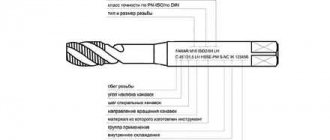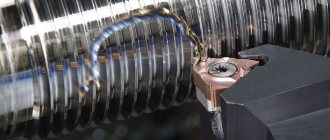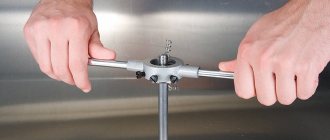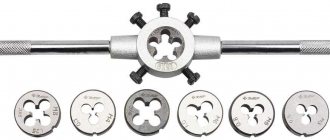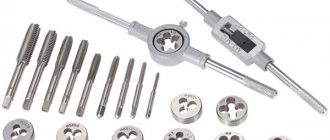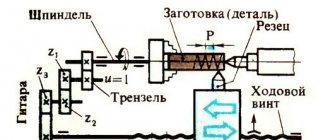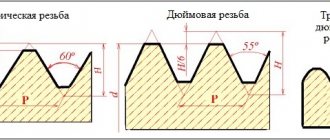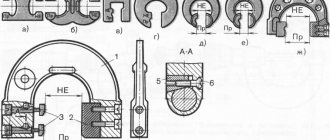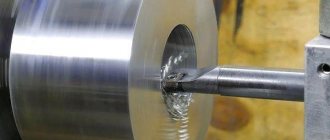A cutter for cutting trapezoidal threads is shown in Fig. 200. The angle between the side cutting edges of the cutter should be equal to 30°; The length t of the leading edge is taken according to the profile of the thread being cut. All angles (α, α1, α2) are selected in the same way as the angles for cutting a rectangular thread. And in this case, holders are used to secure the cutters (see Fig. 199).
The cutter for cutting trapezoidal threads is sharpened according to a pattern similar to that used when sharpening cutters for triangular threads, and in the same order. The sharpened cutter is finished.
Rice. 200. Cutter for cutting trapezoidal threads
Techniques for cutting trapezoidal threads . Installation of the cutter when cutting trapezoidal threads is done in the same way as for rectangular threads. Threads with pitches up to 3 mm are cut with one cutter having a full profile. Cutting threads whose pitch exceeds 3 mm is carried out in several stages (Fig. 201, a). A helical groove is cut with a groove cutter, the width of which is 0.1-0.2 mm less than the width of the thread root. The diameter of the groove “along the bottom” must be equal to the internal diameter of the thread being cut. After this, two cutters (right and left) give the helical groove a trapezoidal shape, and the width of the groove, measured by the outer diameter, should be 0.3-0.4 mm less than the final one. Each of the incisors must have an apex angle of 30°; the length of the front cutting edge of the cutter is made 1-3 mm less than the width of the cavity of the thread being cut. The final finishing of the thread is done with a cutter having a full profile. Only the sides of the thread profile are finished with this cutter.
Rice. 201. Techniques for cutting trapezoidal threads
Another, very productive method of cutting trapezoidal threads is shown in Fig. 201, b. A preliminary groove is cut using a cutter whose width is 0.3-0.4 mm less than the final width of the helical groove, measured by the average diameter of the thread. The diameter of the groove, measured “along the bottom,” should be 0.3–0.5 mm larger than the average thread diameter.
The preliminary groove is then deepened to the inner diameter of the thread.
The width of the cutter used should be 0.2 mm less than the final width of the cavity. The profile is finished sequentially with two cutters that have the full profile of the thread being cut. The first of the cutters has a concave (grooved) front surface, which provides greater ease of chip separation and a clean thread surface. The second cutter should have a flat front surface.
Checking trapezoidal threads . To check trapezoidal threads, limit gauges are used, similar in design to the limit gauges for triangular threads. The profile of the trapezoidal thread is checked with the protrusion C of the template (Fig. 202). If it is necessary to determine the average diameter of a trapezoidal thread, it is checked indirectly. To do this, the template is applied to the thread, as shown in Fig. 202. If the bottom of the template recess touches the top of the thread profile, and points A and B touch its sides, the average diameter of the thread is correct.
Rice. 202. Template for checking the profile and average diameter of trapezoidal threads
It should be noted that this method of checking the average diameter is rough, since the outer diameter of the thread, on the accuracy of which the result of the check in Fig. 202, is processed with a low degree of accuracy. An exception to this are trapezoidal thread screws (lead screws), in which the side surface serves as a mounting base, when cutting threads using steady rests. The outer diameter of such screws is therefore more accurate than conventional ones.
Trapezoidal threads designed to transmit movement are divided into large, normal and small. Depending on the pitch and diameter of the thread, various methods of their manufacture are used. For example, threads with a pitch of up to 4 mm are cut with a cutter whose profile matches the thread profile. In this case, the cutter is installed according to the template so that the main cutting edge of the cutter is parallel to the axis of the part.
Trapezoidal thread cutting
A cutter for cutting trapezoidal threads is shown in Fig.
200. The angle between the side cutting edges of the cutter should be equal to 30°; The length t of the leading edge is taken according to the profile of the thread being cut. All angles (α, α1, α2) are selected in the same way as the angles for cutting a rectangular thread. And in this case, holders are used to secure the cutters (see Fig. 199). The cutter for cutting trapezoidal threads is sharpened according to a pattern similar to that used when sharpening cutters for triangular threads, and in the same order. The sharpened cutter is finished.
Rice. 200. Cutter for cutting trapezoidal threads
Techniques for cutting trapezoidal threads . Installation of the cutter when cutting trapezoidal threads is done in the same way as for rectangular threads. Threads with pitches up to 3 mm are cut with one cutter having a full profile. Cutting threads whose pitch exceeds 3 mm is carried out in several stages (Fig. 201, a). A helical groove is cut with a groove cutter, the width of which is 0.1-0.2 mm less than the width of the thread root. The diameter of the groove “along the bottom” must be equal to the internal diameter of the thread being cut. After this, two cutters (right and left) give the helical groove a trapezoidal shape, and the width of the groove, measured by the outer diameter, should be 0.3-0.4 mm less than the final one. Each of the incisors must have an apex angle of 30°; the length of the front cutting edge of the cutter is made 1-3 mm less than the width of the cavity of the thread being cut. The final finishing of the thread is done with a cutter having a full profile. Only the sides of the thread profile are finished with this cutter.
Rice. 201. Techniques for cutting trapezoidal threads
Another, very productive method of cutting trapezoidal threads is shown in Fig. 201, b. A preliminary groove is cut using a cutter whose width is 0.3-0.4 mm less than the final width of the helical groove, measured by the average diameter of the thread. The diameter of the groove, measured “along the bottom,” should be 0.3–0.5 mm larger than the average thread diameter.
The preliminary groove is then deepened to the inner diameter of the thread.
The width of the cutter used should be 0.2 mm less than the final width of the cavity. The profile is finished sequentially with two cutters that have the full profile of the thread being cut. The first of the cutters has a concave (grooved) front surface, which provides greater ease of chip separation and a clean thread surface. The second cutter should have a flat front surface.
Checking trapezoidal threads . To check trapezoidal threads, limit gauges are used, similar in design to the limit gauges for triangular threads. The profile of the trapezoidal thread is checked with the protrusion C of the template (Fig. 202). If it is necessary to determine the average diameter of a trapezoidal thread, it is checked indirectly. To do this, the template is applied to the thread, as shown in Fig. 202. If the bottom of the template recess touches the top of the thread profile, and points A and B touch its sides, the average diameter of the thread is correct.
Rice. 202. Template for checking the profile and average diameter of trapezoidal threads
It should be noted that this method of checking the average diameter is rough, since the outer diameter of the thread, on the accuracy of which the result of the check in Fig. 202, is processed with a low degree of accuracy. An exception to this are trapezoidal thread screws (lead screws), in which the side surface serves as a mounting base, when cutting threads using steady rests. The outer diameter of such screws is therefore more accurate than conventional ones.
Slicing rules
The quality of the profile depends on many factors:
- Workpiece errors. Underestimation or overestimation of the diameter of the rod and hole, respectively, is the reason for the incomplete height of the turns. The difference in height along the length is a consequence of the taper of the original surface.
- A torn surface is caused by a dull tool, high speed, or incorrectly chosen lubricant.
- Shrinkage of the nut along the average diameter is typical with similar wear of the tap.
- The stretching of the coils occurs due to the braking of the self-extending mandrel.
- Breaking the nut along the average diameter is possible from a large rake angle, which facilitates the pressing of the tap feathers.
To avoid this you must:
- Choose the equipment and cutting method wisely.
- Prepare the workpiece according to the technological documentation or the instructions in the reference tables.
- Select the correct cutting modes and coolant.
- Set up the machine for processing, calculate and assemble the guitar if necessary.
- Control sharpening and installation of the cutter according to the template.
- Check the first finished parts, make adjustments, and periodically repeat the check in the future.
- Monitor the serviceability of devices and sharpen tools in a timely manner. Thread quality control Providing the required service characteristics of the connection is determined by the compliance of the actual values: outer, inner, average diameters, half of the profile angle, pitch. Checks are performed:
- Calibers. They control thread diameters in mass production.
- Pedometers (threaded templates), micrometers with replaceable inserts. The first to check for clearance are P and α/2, the second are equipped with a set of replaceable inserts for different ratings and are designed to measure the average diameter of bolts. They are used in small-scale workshops, measurements are not accurate.
- Accurate measurement of the average screw diameter is performed using three wires, a micrometer or an optimometer. The error of the latter is up to 2 microns.
- Particularly important parts are checked using instrumental microscopes, which make it possible to reliably determine diameters, pitches, and angles.
trapezoidal thread
Please tell me how to cut a trapezoidal thread yourself? External and internal)))
wawbew You must have a lathe with a steady rest, and at least several years of experience.
Alex___dr teks, there is neither one nor the other, then another question is whether it is realistic to buy a stud somewhere (a range of sizes is acceptable) M8-M10-M12-M14-M16 mm with a metric thread and a thread pitch of 3-4mm
wawbew Threaded rods M14 and M16 will have a pitch of 2mm; M18, M20, M22 will have a pitch of 2.5mm; M24 - 3mm.
those. Can’t this even be done to order as an exception?
wawbew Back to the lathe and trapezoidal threading. In a trapezoidal thread, a 3mm pitch starts from a thread diameter of 10mm, a 4mm pitch from 16mm.
those. basically according to my parameters, i.e. M10 etc is suitable for a trapezoidal thread, did I understand correctly?
wawbew If you need a large pitch with a relatively small diameter - yes.
Thank you very much, let's look (c) in order to cut such threads, the machines do not have to be CNC?
wawbew wrote: in order to cut such threads, the machines do not have to be CNC?
You don't need a CNC machine, a regular lathe is enough. In general, you don’t even need a machine; you can easily find a die or tap
newbas wrote: you can freely find a die or tap
And where did you see these? It’s not that I haven’t seen it, it’s actually the first time I’ve heard about such
It is much easier to find some working old turner from the once numerous factories and institutes. Or there are no more factories left in Krasnodar (:
2wawbew Where is this needed? Maybe we can recommend something else. I remembered that on my ancient jack there is a screw with a nut with a trapezoidal thread of only dia. there EMNIP is larger, about 18mm
» > Download the price list and find it. For example, I ordered a ladder M12x2 left
Or there are no more factories left in Krasnodar
There are none left, but I have a lathe. It’s just faster and easier to use a ready-made tap - the hole is through, and my size is F12. And if there is no machine, then only a tap and a die
newbas wrote: In general, you don’t even need a machine, you can easily find a die or tap
Vidis wrote: And where did you see these?
I join the question.
Vidis wrote: It’s not that I haven’t seen it, it’s actually the first time I’ve heard about such
2Alex___dr Gugel rules. It’s just that such threads are not very common - jacks, lead screws. I don't know anymore.
Only this is a rather unique tap.
newbas wrote: Just using a ready-made tap is faster and easier -
But not cheaper. » > Neither the reference book nor Google knows about dies for trapezoidal threads.
Vidis wrote: 2wawbew Where is this needed? Maybe we can recommend something else.
Depending on the load on the thread, screws with a pitch of less than 3 mm can be used. Only the speed of movement will decrease or the number of turns of the handle will have to be made more.
Here in hardware they sell two-meter studs M8-M10-M12-M16. .
Alex___dr wrote: Message from Vidis And where did you see these?
I join the question.
Only special orders at factories. But he held it in his hands.
MMR ladder 12x2 left - set (No. 1 and No. 2) - 1180 rubles with VAT » >
when I was a turner on my native collective farm (I turned there for 3 years, all sorts of crap had to be repaired), I cut such threads on a regular 16v20 lathe. True, they didn’t come across diameters smaller than 16. But 16 at a length of 600 with normally bored jaws was cut in half an hour. Screw + 25 minutes nut. It cost about 200 rubles (a bottle of good vodka, some money).
Types and properties of cutters
Classification
In practice, cutters for external and internal threads with a rectangular section holder are used. Less common are disc, prismatic, sharpened along the front surface. The working profile of all corresponds to the dimensions of the screw groove. In the direction of the cut spiral, left and right ones are released.
There are solid and prefabricated instruments. The first ones are mainly made of high-speed steel, small section or disk. The bulk is equipped with cutting plates secured by soldering with refractory solder or mechanically, allowing replacement when worn.
Threaded cutters: external (Fig. 1), internal (Fig. 2)
Features that a trapezoid in thread provides
Original angles - profile at 15-40 0 and rise at 30 0 - determining the pattern of grooves;
Minimal friction (with proper selection of lubricant);
Self-braking, virtually eliminating the possibility of part deformation, even if it is subject to severe loads;
Impressive wear resistance (better than tubular or rectangular).
These properties are most clearly manifested in notches with a medium pitch: with their use, fairly accurate axial movements are achieved.
The easiest way to check the distance between the turns is with a caliper: measure the area on the rod, count the number of grooves, divide the found length by this number, get the result, check it with the reference data and make sure that it is within the normal range.
Now about why in the accompanying documentation you can often see the entry “trapezoidal thread Tr”: GOST 9484-81, which also regulates markings, establishes that when applying symbols the Latin alphabet should be used. And these two letters indicate the type of notches.
This profile design has a number of advantages:
When placed in the middle of a double radius, it is not difficult to identify radial clearances.
With it, complex devices and functionally complex objects can be repeatedly dismantled and constructed, and the process of their construction is simplified.
Due to the screw and nut, it ensures the conversion of rotation into translational motion, which means it has a positive effect on the overall performance of the mechanisms.
Allows you to adjust the compression force as needed, which speeds up the assembly of functional units.
Does not reduce the strength or other useful characteristics of the finished product - the quality of the latter is affected by the material, and not the number or geometry of the turns.
But trapezoid carving, the dimensions of which we will consider below, also has certain disadvantages:
If friction is still observed, it will provoke the appearance of significant stresses in the areas of the depressions.
This cutting pattern is not suitable for mechanisms used under strong vibrations - with constant vibrations, the fasteners can be unscrewed arbitrarily.
High cost in multi-pass design - they cost relatively high, are demanding on the technological base, and their production consumes a lot of electricity and time.
Therefore, it is not relevant everywhere, but in strictly defined areas - it is applied to specific parts, the number of which is usually extremely limited.
Technology for using taps and dies
The tap is used when it is necessary to cut internal, mainly metric threads in holes of small diameter. It is a screw-shaped steel rod with grooves for chip removal located in the longitudinal direction. The tool consists of the following parts:
- Shank;
- Calibration part;
- Fence part.
To form a high-quality thread with a tap, 3 types of this turning tool are used sequentially, which can be distinguished by the number of marks placed on the shank:
The speed of work on a lathe with installed taps can be quite high. As an example, for aluminum, cast iron and bronze parts this technology indicator is about 6-22 m per minute, while for other materials it is from 5 to 12 m per minute.
The die is designed for cutting external threads. It is a flat cylindrical tool, in the center of which there is a hole with sharp edges and channels for removing chips. It looks like a nut. The calibrating part of the die is located in its middle, and the intake cone is located on each side. The tool on the lathe is fixed into a die holder - a special chuck in the tailstock quill. In order for the tool to enter the workpiece without effort, a chamfer is removed at the end of the workpiece, the height of which corresponds to the thread profile.
The dies can be split or solid. The diameter of the former is subject to adjustment within small limits, which makes it possible to restore the performance characteristics of the tool after wear. Solid versions are used to form high-precision threads. Alloy or carbon steel is used in production.
When using a die on a turning machine, the surface of the workpiece is subjected to preliminary turning to the required thread diameter, but taking into account the following tolerances:
- For threads 6-10 mm, the tolerance is 0.1-0.2 mm;
- For 11-18, the tolerance is 0.12 - 0.24 mm;
- For 20-30 mm, the tolerance is 0.14-0.28 mm.
The speed of thread cutting with a die installed in a lathe is adjusted in accordance with the workpiece material and directly affects the wear rate of the tool:
- For steel - 3-4 m per minute;
- For cast iron - 2-3 m per minute;
- For brass - 10-15 m per minute.
Application of Die Heads
When cutting threads on a screw-cutting lathe, the use of threading heads is used less frequently than the tools described above. The role of their working element is made by special combs of several types:
- prismatic;
- tangential;
- round;
- radial.
The first type of dies is used for cutting internal threads, the remaining three are used for external threads. A special feature of the tool is the automatic divergence of the working parts during the reverse stroke, which prevents their contact with the newly formed screw threads.
Threading heads on the machine are used mainly when high-precision work is required. When cutting threads on long screws and worms, the tool is mounted on the machine support. Round cutters are the most popular, as they are easy to maintain and have increased durability. For cutting internal threads on turret-type machines, exclusively prismatic dies with a special lead-in cone are used. The work is completed in one pass.
- To check the condition of the thread during its cutting on the machine, a thread template is used - a tool consisting of plates placed in a cassette on which there are notches. The thread pitch is indicated on the flat part of the template.
- For comprehensive control, thread gauges of the go-through type (with a full thread profile) and non-go-through type (with a shortened profile, to check the average diameter) are used. They must be handled with extreme care. Otherwise, scratches and nicks may form on the jagged surface.
- The diameters of the cut thread, as well as its pitch, are checked with a thread micrometer - a tool equipped with mounting holes in the spindle and heel, which act as fasteners for replaceable inserts. The micrometer is installed in the rack, after which it is adjusted according to the standard sample.
- Before checking the thread of a part with any of the specified tools, it must be cleaned of dirt and chips without removing it from the machine.
Trapezoidal thread: diameters and pitches according to GOST 24737-81
This interstate standard specifies values up to 640 mm for the cross-section and up to 24 mm for the distance between adjacent turns. But we will focus only on common values that are used frequently, and not in isolated cases.
Focus on these reference data when choosing a cutting option and remember: standard values of geometric parameters are the key to high compatibility of parts and especially fasteners.
Let's look at the most common and used design options today.
Trapezoidal thread left
It is applied with a flat contour blade rotating counterclockwise (as if from the observer).
This type of connection has been known perhaps the longest, but even now it remains relevant - in the following areas: In mechanical engineering - for fixing various parts on the machine shaft; it practically eliminates self-twisting of the workpiece during its processing.
As a universal fastener - wheels of SUVs and trucks, radiator nipples in heating systems, fan blades, bicycle units, motor gearboxes, circular saws, chucks with drills, and so on.
To control the trajectory of cutting and other tools - it is a kind of means of stopping production when dangerous situations arise.
In the automotive industry - to protect original factory components from counterfeiting.
It is very easy to distinguish it from others - by the letter “L”, with which it is required to be marked.
Right
This trapezoidal thread, according to GOST standards, is applied clockwise - a flat contour blade creates it, moving along in relation to the observer’s position. This is the main type of notch on screws, bolts, nuts and studs, and most screws and dowels used on an industrial scale also have it.
It is not difficult to understand that it has exactly this direction: just place the fastening element on your palm with the chamfer facing up and see where the turns are directed - they should come from you. Another obvious indicator is the letter “R” on the side of the product. Although it is not difficult to fake this option of applying grooves, that is why the same manufacturers of auto components are indifferent to it.
Where right-hand cutting is actively used is in the production of oxygen cylinder reducers in order to prevent an emergency when using them.
Single-start trapezoidal thread: main dimensions
Its pitch and diameter are regulated by interstate standards 24739-81 and 25347-82, along with the maximum possible processing tolerances, and will be given below. Now we want to focus on such a distinctive feature as the geometry of the pattern.
It got its name because it is performed by moving one blade. And it’s quite easy to determine that this is it: you just need to look at the end of the fastening element - 1 end of the turn should go out to it, but no more.
The distance between adjacent threads always coincides with the stroke value, so choosing, adjusting and maintaining it during application is relatively simple (and this is its advantage). The disadvantage is the relatively low strength of the connection of the final product and is explained by the fact that the internal diameter is too short to ensure reliable contact. Therefore, it is problematic to transfer significant loads with it, which means it is of limited use.
It will not be difficult to recognize it by its marking - the Latin letter “H”.
Multi-start ladder thread: GOST, dimensions
You probably already understood how it differs from the previous one: its groove pattern is formed by several blades at once. Therefore, on one thread there are 2 or 3 turns at once. In practice, it is its two- and three-way varieties that are most in demand, which means we will consider them as examples.
Such notches are relevant for tension structures - they are:
MACHINE-TOOLS
Main menu
- home
- Lathe Device
- Metal cutting basics
- Safety precautions
- Turning cylindrical surfaces
- End surface processing
- Turning external grooves
- Drilling holes
- Centering
- Boring cylindrical holes
- Turning of simple parts
- Principles of constructing technological processes
- Machining of conical surfaces
- Turning shaped surfaces
- Surface finishing
- Threading
- Construction of lathes
- Checking the machine for accuracy
- Mechanization and automation
- General information about cutting
- Cutting Process Basics
- High-performance metal cutting
- Cutting rectangular and trapezoidal threads
- Turning of parts with complex installation
- Rational turning methods
- Technological process of processing parts
- Bushing processing
| Cutting rectangular and trapezoidal threads |
| Added by Administrator |
| 18.12.11 22:00 |
| Cutting rectangular and trapezoidal threads is considered one of the most difficult turning operations. These threads are made single-start and multi-start. Rectangular thread cutter (Fig. 321). The cutter must be sharpened according to a template, the profile of which corresponds to the thread profile (Fig. 322). The rake angle of the cutter is usually 0°, the main rear angle a = 6 - 8°. Auxiliary cutter clearance angles a1 and a2 are assigned to eliminate friction of the cutter on the side surfaces of the thread. The larger the thread helix angle, the larger the rear auxiliary angle a1 should be. This angle is usually taken 2 - 3° more than the angle t of the thread (see Fig. 323); the rear auxiliary angle Qg is equal to =3′ regardless of the thread helix angle. Installation of cutter. There are two ways to install a thread cutter when cutting rectangular threads. First way. The main cutting edge of the cutter ab can be installed parallel to the axis of the part (Fig. 323, left), exactly along the line of the centers of the machine; in this case, the resulting thread profile will exactly match the profile of the cutting part of the cutter and the screw will receive the correct shape. However, the cutting angles at the right and left side cutting edges will be different: at the right edge the cutting angle 6i is obtuse and the cutter in this place will not cut the metal, but scrape it; at the left edge, cutting conditions are more favorable, since the cutting angle 6з will be significantly less than 90°, but this edge will be greatly weakened and will quickly become dull. Second way. The main cutting edge a' b' is installed perpendicular to the side walls of the thread, as shown in Fig. 323, right. In this case, both side cutting edges will cut equally well, but the thread profile will not exactly coincide with the cutter profile - the bottom of the groove will be concave rather than flat. For this reason, this setup is usually used only for rough groove cutting. During finishing passes, the cutter must be installed according to Fig. 323, left. In this case, it is necessary to ensure that the tip of the cutter is exactly at the height of the centers. Innovative turners use special holders to install cutters when cutting threads, rectangular and trapezoidal profiles (Fig. 324). These holders are convenient because they do not require special sharpening of the cutter when changing the lead angle of the thread. In addition, frequent regrinding of cutters when the diameter or number of thread starts changes is eliminated.
Cutting external trapezoidal threads . Trapezoidal threads have a trapezoidal profile with an apex angle of 30°. The inclination of the sides of the trapezoidal thread profile facilitates the flow of chips and allows them to be cut more cleanly and accurately than rectangular ones. The sharpening angles and installation methods with the cutter are the same as when cutting rectangular threads. Depending on the size, accuracy and cleanliness, trapezoidal threads can be cut with one, two, three or four cutters. Small trapezoidal threads are cut with one cutter with a cutting part corresponding to the thread profile; large threads are cut with two, three or four cutters. Cutting a trapezoidal thread with four cutters is shown in Fig. 326. Using a slotted cutter having a width equal to the width of the groove on the inner diameter, a cavity (groove) is first cut to the depth of the inner diameter of the thread (Fig. 326, a). After this, install a trapezoidal cutter with an edge slightly smaller than the profile width of the thread being cut, and use it to cut first the right and then the left side of the thread (Fig. 326, b, c). The final finishing of the profile is carried out with a thread cutter (Fig. 326, d), the profile of the cutting part of which corresponds to the thread profile. In Fig. 327 shows more productive techniques for cutting trapezoidal threads with a slotted and two scoring cutters. First, with a slotted cutter having a width equal to the full width of the groove at the bottom, the groove is cut to the inner diameter (Fig. 327, a). Next, two scoring cutters are used - left and right. The left side ledge is cut with the left scoring cutter, and the right ledge is cut with the right scoring cutter. Although this method is simpler than the previous one, it is only accessible to highly qualified turners.
To cut trapezoidal threads, cutters with plates made of T15K6 hard alloy are used. Cutting is done with two cutters - roughing and finishing. The rough cutter (a) has a profile angle of 50°, rake angle γ = -3° and clearance angle a = 3-5° (to increase the strength of the cutter). The finishing cutter (b) has a profile angle equal to the thread profile angle (in this case 40°). Threads are cut in 6-7 passes with a cutting depth of 0.6-0.7 mm, with the last pass being a cleaning pass; at the same time, the cutting speed is from 155 to 450 m/min when processing steel with cutters equipped with T15K6 hard alloy. Checking the thread profile . To check the root profile of trapezoidal and rectangular threads, templates are used that are made for each profile and each thread pitch. In Fig. 330 shows a template checking a trapezoidal thread profile. The template is installed perpendicular to the helical line of the thread and the correctness of the cavity profile is determined by its fit to the side walls of the thread (lack of clearance). Cutting internal trapezoidal threads . Internal threads are cut in the same way as external threads of the same profile. Threads with a pitch of up to 3 mm are cut immediately with one cutter with a profile of the cutting part corresponding to the thread profile. The cutter in the tool holder is installed exactly according to the template.
|
Application
Let us immediately emphasize that due to the excellent braking properties and the ability to withstand significant friction without deformation, literally all of its varieties do not require additional fastening. Therefore, in most situations it becomes a lead screw - a kind of drive for presses.
In practice, Tr (trapezoidal thread GOST 9484-81) helps solve the following problems:
Control the trajectory of actuators, lifting and other mechanisms.
Feed and stop movement on machines.
Ensure the movement of workpieces and products along the conveyor belt to the assembly point.
Support the press (and similar machines) in a given direction, most often vertical.
It is also applied to the surfaces of parts that are components of regulators, machine tools, and complex equipment.
The list of main areas of its use:
And the secondary industry is parts of motor gearboxes.
Mechanical engineering – functional units of various units.
Steam locomotive engineering – braking devices for electric locomotives operating in mines.
And separately, robotics with ultra-precise design (in especially critical and isolated cases).
Application of cutters
When cutting threads with a cutter, the following types of this tool are used:
1. Round. Installed in the hole in the end of the holder. They belong to the shaped type of incisors. Used for internal and external processing of workpieces.
2. Rod. The heads are made of various shapes and sections, located on the rod. To increase the service life of the tool, some models have hard alloy brazing on the working edges.
3. Prismatic. Installation on the lathe is carried out using a dovetail holder. They are subject to more sharpening than round versions and are suitable for processing parts exclusively from the outside.
The outer threaded surface can be cut on a machine with both straight and bent versions of the tool mounted in a mandrel, and the inner one can be cut with curved and straight ones. High-speed steel is used in the manufacture of cutters. Detailed characteristics are standardized, and together with diagrams and drawings are indicated in GOST 18876-73.
The thread profile corresponds to the configuration of the tip of the cutter, which, in turn, can be rounded or have a chamfer. Depending on the material of the workpiece, the rake angle of the tool is selected (0-25 degrees). Thus, for hard and brittle parts this parameter is less than for those made of viscous and non-ferrous metals. There are detailed diagrams for choosing the cutting angle for most materials. Before cutting an internal thread on a machine, it is necessary to drill a hole or additionally bore it.
The rear lateral angles of the cutters are set to be the same on the right and left sides, and are selected in such a way that there is no friction between the surface of the tool and the groove formed by it. When the thread lead angle does not exceed 4°, the indicator is set in the region of 3–5°. Otherwise, the angle is set within 6 - 8 degrees.
When cutting threads on conical and cylindrical steel workpieces, cutters with carbide inserts T15K6, T30K4, T14K8, T15K6 are used. When working with cast iron parts, tools made of VKZM, V2K, VK6M, VK4 alloys are used.
Technology for using turning tools:
- The cutter is fixed in the tool holder, and the workpiece is fixed in the centers or chuck of the machine.
- The cutter moves along the axis of rotation of the workpiece, drawing a helical line. Both movements are strictly consistent with each other. In other words, during one revolution of the part, the cutter moves by the calculated pitch of the future thread.
- The support is driven by the spindle through the gearbox and lead screw. In this case, the gear ratio must be equal to the ratio of the pitch of the lead screw to the pitch of the thread being cut.
- The cutter is fed according to one of the following schemes: parallel to the generatrix of the thread (only the cutting edge is in contact), perpendicular to the axis of rotation of the workpiece (the entire profile is in contact).
- To form threads with large pitches on a machine, the workpiece is pre-processed with a slotted cutter. Its profile angle differs by 5-10° from the thread profile angle.
- Labor productivity when working with lathes is low, since a lot of time is spent reversing the cutter and setting it to size.
- The work requires increased attention and is performed exclusively by a highly qualified specialist.
Read also: What is a diode for dummies
Trapezoidal thread: dimensions table
Its main geometric characteristics are:
Nominal diameter (nominal diameter) is 1.5-48 mm.
The average angle is 30 degrees.
The pitch - the distance between adjacent turns (at identical points) - lies in the range of 0.75-24 mm.
The gap is up to a maximum of 0.5 mm.
All this is official statistical data, given in even more detail in the interstate standard 24737-81. We will present the main ones right now – in the most visual format:
How to thread a bolt and nut
The question of how to cut the thread of a bolt or nut is far from idle. During repairs, apartment and house owners are faced with the need to restore old threads of anchors, bolts, nuts, or simply threads found in metal plates.
Or you may even need to cut a new thread on the bolt or nut. For professional turners or mechanics, this task does not present any difficulties, but those who have never encountered such a process need to arm themselves with some theoretical knowledge, which is outlined in this article.
Technique of cutting on a metal part
The helical surface formed by the cutter is called a thread. It provides fundamental tasks - with its help, elements of parts can move relative to each other, articulate or significantly seal joints in various mechanical devices.
Cutting trapezoidal thread 28x5 (screw, nut)
To understand how to cut a thread on a lathe, you need to follow the cutting process - it is quite simple and understandable. The cutter is fixed in the support of the lathe. It moves moderately along the axis of the rotating part. The pointed tip of the tool cuts a helical line on the surface of the part.
To correctly install and align the cutting tool, use a special template, which is placed above the blank. The cutter is placed along the axial cutting line of the machine. The resulting gap determines how accurately the thread is cut.
Cutting has its own corresponding features:
- the process of thread formation has certain features;
- the material from which the part is made determines the front angle of the cutter;
- the angle depends on the viscosity, hardness and fragility of the metal;
- the cutter planes on the rear side corners should not rub against the cut grooves;
- internal threads are cut into already bored or drilled holes.
For each processed material, certain metal-cutting tools are provided. For steel blanks, cutters are used whose plates are made of hard alloys T15K6, T14K8, T15K6, T30K4. For metal workpieces, cutting tools with carbide inserts VK4, V2K, VK6M, VK3M are used.
Characteristics of metric thread
Before you begin the practical steps of thread cutting, you need to know its basic parameters and types. In the construction and renovation of housing, metric threads are used in most cases. What does it mean? According to the shape of the tooth, the thread can be metric, inch, rectangular, trapezoidal, etc.
Characteristics of metric thread
The thread we are interested in has the shape of a triangle, while the trapezoidal thread has the shape of a trapezoid. In addition, there is such a thing as a thread pitch, that is, the distance between its vertices: in the case of a metric thread, between the vertices of the thread triangle. And, of course, the characteristics of the thread include its diameter.
Let's consider the paragraph described above using the example of the M 12 thread, where the letter “M” indicates that the thread is metric, the number “12” determines the diameter of the thread. Where is the step size? The fact is that metric threads are divided into main and small, and if there is no other digital value after the number, it means the main thread. But if we have a thread M12 x 1.5 or M 12 x 1.25, then this means that the thread pitch is 1.5 and 1.25 mm, respectively. The pitch of the main thread M 12 is 1.75 mm.
Recommended drill diameters (in mm) for cutting metric threads
All these values for any type of thread can be found in reference books or on the pages of the corresponding websites on the Internet. For internal threads (nuts), there is another reference value - the diameter of the thread hole, which can be found there. For our M12 bolt, the internal diameter of the nut should be 12 mm minus the height of the tooth profile, that is, according to the reference books, 10.2 mm. For small thread M 12 x1.25, the diameter will be correspondingly smaller - 10.4 mm.
It is worth noting that something similar applies to a bolt or, as it is called in reference books, a rod. Again, for an M 12 thread, the diameter of the rod should be slightly less than 11.7 mm, but for an M 12 X 1.25 thread - 11.9 mm. If you do not comply with the dimensional tolerances for the threads for both the nut and the bolt, the thread will be of poor quality, weakened on one side, and on the other, if the tolerance is larger, it will simply break.
Thread parameters
Before we dwell in more detail on how to cut a thread on a lathe with a cutter, let’s take a closer look at the basic elements of a helical groove. It can be found both on iron rods or nuts, and on pipe fittings in gas, heat and water pipelines. For the properties of a thread, the following main elements of its profile (longitudinal section) are distinguished:
- External diameter;
- Thread pitch;
- Apex angle.
Screws for carpenter's vice. trapezoidal thread
Across the diameter, standard metric threads up to 6 mm have a pitch of 1 mm, beyond that - 2 mm. If necessary, it is easy to cut seven-millimeter or nine-millimeter threads on the machine. It is impossible to perform such work with hand thread-cutting tools - taps and dies.
Based on the thread pitch, they are divided into standard (1 mm), small (less than 1 mm) and large (more than 1 mm). Typically, all taps are designed for a standard distance between turns. You can get small or large threads only on a screw-cutting lathe.
Based on the angle at the top of the thread, they are divided into metric (angle is 60°) and inch (angle is 55°). For manual cutting, you need to have a set of tools for each diameter with different angles. For mechanical cutting, it is enough to purchase only two threaded cutters with suitable sharpening angles.
Accessories and tools for thread cutting
Don’t be afraid of the word “equipment” because, in essence, this is a device where the cutting tool is attached: taps and a die (cutter). The old name of the die is given in parentheses, but it can still be found. The equipment includes wrenches of a fairly simple design into which a tap is inserted for cutting threads in nuts and another type of device where a die for cutting bolt threads is attached.
Accessories and cutting tools for thread cutting
Taps, as well as dies, are made of high-carbon cast iron, so they are fragile and susceptible to heavy loads. Threading in nuts is mainly carried out by two taps: N 1 and N 2. The first has an incomplete thread for preliminary penetration, following which the second tap makes the cut.
Taps for thread cutting
As a result, the thread is full and of high quality, which means it will firmly hold the connection with the nut. Another type of tap is used, called a "machine" tap, which combines two tap numbers.
Die holder and die set
It would seem convenient, but this type of tap is long and inconvenient to use. Used for cutting long threads. As for the dies, they have one number.
Another type of equipment, without which the thread cutting process is almost impossible, is a medium-sized bench vise. What this is, probably, no one needs to explain. The only thing to remember is that the vice must be securely fastened.
Table of recommended threaded hole diameters, mm
The table shows that the diameter of the drill is less than the outer diameter of the thread by approximately the pitch, that is:
In practice, many home craftsmen constantly use this simple formula when it is not possible to refer to the table.
For example, for M10x1.5
: Dot = 10 – 1.5 = 8.5 mm
This method is quite acceptable when thread cutting is performed manually in a metal workshop. If the planned threaded connection is not subject to serious loads during operation, then a slight increase in the size of the hole can be allowed. In assembly production, where high precision of thread profile dimensions is required, any deviations are unacceptable. The diameters of the threaded holes with the tolerance range are established by GOST 19257-73.
Thread diameter d
Thread diameter d
Thread diameter d
Notes: 1) When choosing diameters, you should prefer the 1st row to the 2nd.
2) When choosing thread pitches, average values should be preferred.
Threading techniques
It is immediately necessary to make a reservation that the rod at the end and the threaded hole in the nut must be chamfered by any available method. Chamfers are necessary for precise entry without distortion of the cutting tool, that is, the tap and die. Next, we clamp the thread cutting object into the driver, clamp the rod or workpiece under the nut from a vice and proceed to thread cutting.
Thread cutting with a die
This is done without the use of excessive force and always with a lubricant, for which sulfo-fresol is ideal. However, if this is not available, you can use an emulsion (a solution of mineral oil in water) or simply vegetable oils.
By the way, if you decide to cut the thread of a bolt made of stainless steel or copper, there is no better lubricant than ordinary lard, which has been tested more than once in practice.
When cutting a thread, you need to feel the tap or die: if they begin to spring a little, that is, resist strongly, you need to turn them out and clear them of chips. If this is neglected, the cutting tool may simply crack and you will have to prepare a new rod or blank for the nut again.
And finally: if you do not have the opportunity to order blanks for a bolt or nut from a turner, purchase round timber (rolled metal in the form of a circle), which can have a diameter of five to 20 mm, and you don’t need more, because it is almost impossible to cut large-diameter threads by hand.
Cutting tool - die
A die is a cutting turning tool made in the shape of a nut. The holes drilled in it are made to remove chips. The tool consists of cutting elements located on each side and forming a fence cone. A die on a lathe forms threads on bolts, studs, screws and other metal products.
- metric;
- left;
- pipe
Thread cutting with a die should be preceded by processing the desired area of the part. In this case, the outer cross-section of the thread must be larger than the machined area of the part. The difficulty of cutting a thread with a die is that it does not have a special lead, which makes it difficult to cut the initial turns smoothly.
You can make the task easier by making a small chamfer at the end so that its height coincides with the height of the thread profile. The size of the die must match the diameter of the part.
Then the die of the required size is fixed in a die holder fixed in the tailstock of the lathe. The thread cutting speed depends on the material for the workpiece: brass products are processed at about 15 m/min, cast iron - 3 m/min, steel blanks - 4 m/min.
At this processing speed, the die wears less. During the cutting process, each rotation of the die must be replaced by turning it back a third of the circle to clear the holes from chips.
External thread cutting with a die
To cut external threads, you will need the following tools and materials: a die or pipe clamp, a die holder, a file, a vice, a caliper, and machine oil.
The most widespread are round dies (lerks). They are either solid or split. The diameters of solid round dies are standardized. This allows you to choose the appropriate option from a large range of sizes, for example, M10, M12, M14, M16.
A special feature of split dies is the ability to adjust the diameter of the thread being cut within 0.1…0.25 mm. However, they have reduced rigidity, which affects the accuracy of the resulting profile.
The die is installed in a die holder of a suitable size. After this, it is secured with screws. In the case of external pipe threads, die holders with a ratchet are often used. They provide convenience for working in hard-to-reach places, such as near a wall.
The thickness of the rod is chosen to be 0.1...0.25 mm less than the diameter of the external thread. For example, for M6 with a large pitch it is 5.80...5.90 mm; M8 – 7.80…7.90 mm; M10 – 9.75…9.85 mm. Measurements are taken using a caliper. The diameters of rods for cutting metric threads of average accuracy class 6g are presented in the table.
To ensure better insertion of the die, a chamfer is filed at the end of the rod. Its width should be 1 - 1.5 mm for M6 ... M18. The workpiece is lubricated with machine oil, which makes subsequent work easier and allows you to obtain a better surface.
The die is placed on the end of the rod so that its plane is perpendicular to the axis of the bolt being cut. Next, with slight pressure, rotate the die holder clockwise (if the thread is left-handed, then counterclockwise). When the die cuts into the rod by one or two threads, it should be turned back half a turn for better removal of chips. After this, they again make 1-2 turns along the thread and 0.5 in the opposite direction. Using this scheme, the bolt is cut to the required length.
The diameter of the external thread is checked with a regular nut or ring gauge. If necessary, the pitch is controlled with a thread gauge.
Threading technology
Based on the indicated characteristics, the appropriate cutter and thread cutting modes are selected. Before you begin to obtain a helical groove of a triangular, rectangular or trapezoidal cross-section on the surface of a part, you need to grind the workpiece to the desired diameter.
This type of work is carried out with a standard through cutter at appropriate speeds. Due to the partial expansion of the metal during cutting, the diameter of the workpiece must be made 0.1 mm smaller than the required diameter of the future thread.
The next step is setting up the machine, and more specifically, the guitar mechanism that regulates the feed speed of the cutter. Using the appropriate tables, depending on the desired step, you need to install the required gears. Then you can cut the threads on a lathe.
To do this, install a threaded cutter with the desired sharpening angle into the tool holder and use the handle for connecting the caliper to the lead screw to control it. Thanks to this device, the tip of the cutting tool produces a spiral movement along the surface of the part, evenly, pass by pass, deepening to the required depth until a complete triangular profile is obtained.
To obtain the best properties of the manufactured thread, do not forget to occasionally lubricate the surface of the part with machine oil. This will reduce the roughness and partially cool the rod being processed. You can take a closer look at the technology for producing threads on a lathe on the proposed
4, total, now
